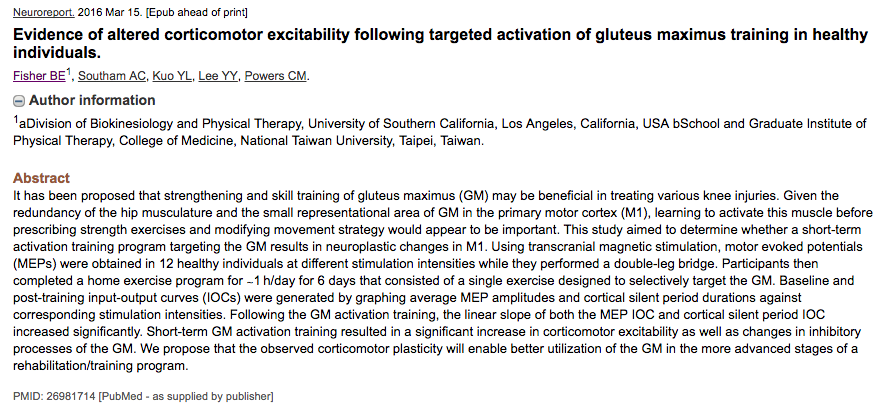New Research: Targeted Glute Activation Training Makes the CNS More Efficient at Recruiting the Glutes
Low load glute activation drills during the general warm-up have become increasingly popular in strength & conditioning, and they’re heavily used in the physical therapy setting as well. Some researchers and coaches have questioned their legitimacy, claiming that the glutes function optimally without any targeted training.
A new study was just published showing that only six days of intensive targeted glute training elicited some exciting corticomotor adaptations. It’s the first study of its kind. Here’s the PubMed link:
Evidence of altered corticomotor excitability following targeted activation of gluteus maximus training in healthy individuals

Some of you may notice that popular hip/glute/knee researcher Dr. Chris Powers is named on this study. The other researchers listed on the study appear quite impressive as well.
Here’s the gist of the study. The researchers had healthy subjects perform a quadruped band glute isometric exercise (sort of a combined hip extension, hip abduction, and hip external rotation drill) for one minute at a time for an hour per day (three 20 minute sessions) for six days. Here’s the exercise:

Yes, that’s indeed a boatload of targeted glute training in a short period of time. But this was needed to show whether adaptations can quickly take place with an aggressive protocol. The researchers went with an isometric as opposed to a dynamic exercise as they felt it would lead to greater mental concentration and thus potentially greater neuroplastic adaptations.
At the end of the week, they found that the training led to significant increases in corticomotor excitability and efficiency. They had subjects glute bridge against an anchored bar before and after the training period while utilizing transcranial magnetic stimulation (TMS) on the head and electromyography (EMG) on the gluteus maximus. Here’s the set up:

I won’t go into detail about the methods used by the researchers to determine changes in neuroplasticity, but they looked at the input-output curves and maximum stimulator outputs of motor evoked potentials and cortical silent periods, in addition to their slopes at different intensities of contraction. Here were the results:

Since the exercise used during the training period (band quadruped hip ext/abd/ext rot) was more isolating of the glute than the exercise used during testing (glute bridge uses glutes and hamstrings), the changes in corticomotor excitability and inhibition suggest that targeted glute training enhances gluteal recruitment efficiency during tasks that are more integrative in nature. This could be especially beneficial in athletes who may experience less stress on the patellofemoral joint, the ACL, the ITB, the SIJ, the anterior hip, the hamstrings, and the adductors by better recruiting the gluteals during forceful and explosive sporting actions.
The next step is to determine if this enhanced gluteal recruitment efficiency improves outcomes involving hypertrophy, strength, mechanics, and injuries.
I will leave you with some quotes from the authors:
“Interestingly, greater excitability as shown by the slope change was observed in a task that did not isolate the GM (i.e. bridging). This suggests that the neuroplastic changes following specific GM activation training may be generalized to movements involving other hip muscles (i.e. hamstrings). Although an increase in system efficiency was most likely because of changes in synaptic strength, it is not possible to determine the mechanism of this increase from the current study. It could potentially have been driven by a change in neurotransmitter release at the synapse, enhanced strength of inhibitor neurotransmission (gamma aminobutyric acid) or decline in excitatory neurotransmission (glutamate), changes in receptor density, or other potential causes.”
“To the best of our knowledge, the current study is the first to report changes in corticomotor excitability of the GM after a short-duration activation training program. As noted above, an increase in corticomotor excitability of the GM implies better efficiency of the GM corticospinal motor system, which, in theory, would allow for better recruitment of the GM during more advanced, skillbased hip strengthening exercises. The increase in CSP duration may reflect a refined inhibitory mechanism to ensure muscle recruitment specificity. Thus, this GM activation exercise may be considered a method to prime the brain for subsequent GM strengthening by enabling an individual to target GM activation more precisely.”
“As recruiting the GM agonists such as the hamstrings and/or adductor magnus may have an undesired influence on lower limb kinematics as both muscles act as hip adductors, adequate GM muscle activation would appear to be critical for injury prevention. Further study is needed to determine whether the observed changes in corticomotor excitability of the GM results in greater muscle activation during hip-strengthening exercises. Moreover, such plastic change in M1 can be considered an initial central adaptation before a peripheral adaption such as increased muscle strength or muscle hypertrophy. A long-term follow-up to investigate the persistence of this plastic change with a self-driven home program is warranted.”
“Our findings show that short-term activation training increased corticomotor excitability of the GM, with prolonged CSP. The increase in corticomotor excitability as evidenced by increased MEP amplitude and active inhibitory processes (as evidenced by an increase in CSP duration) reflects a more efficient GM corticospinal motor system with ability to modulate muscle activation specificity. We propose that the changes in corticomotor excitability following activation training would make the GM more available in advanced stages of training programs such as specific strengthening and skill training.”
The post New Research: Targeted Glute Activation Training Makes the CNS More Efficient at Recruiting the Glutes appeared first on Bret Contreras.

